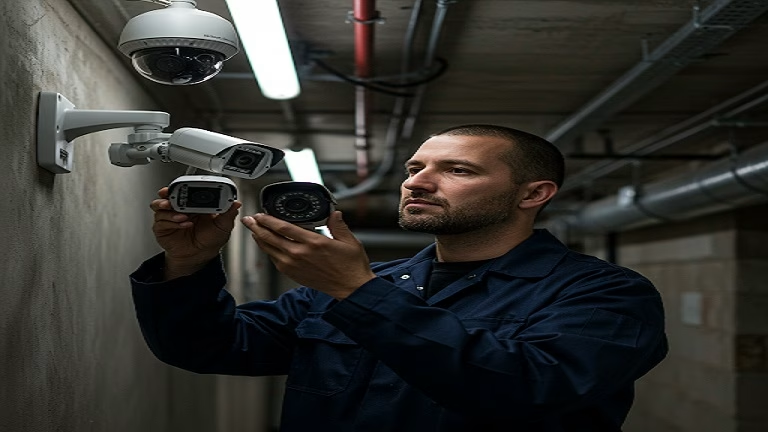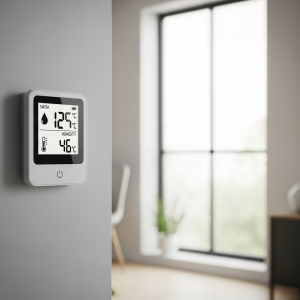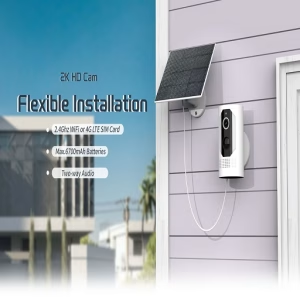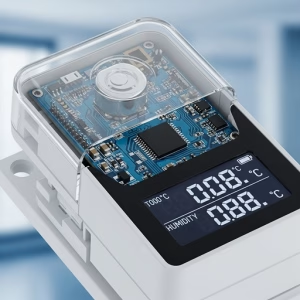Fixed vs Varifocal : How Do They Differ?
Choosing the Right Security Camera Lens for Your Needs
Fixed vs Varifocal : How Do They Differ? When setting up a security system, one of the most crucial decisions you’ll make involves the type of lens your security cameras will utilize. Two primary categories dominate the market:Fixed vs varifocal,Understanding the fundamental differences between these lens types is paramount to ensuring your surveillance system effectively captures the footage you need, precisely where and how you need it.
This comprehensive guide will delve deep into the characteristics, advantages, disadvantages, and ideal applications of both fixed and varifocal lenses. By the end, you’ll be equipped with the knowledge to make an informed decision that optimizes your security investment and provides robust coverage for your property.
Understanding the Basics: What is a Camera Lens?
At its core, a camera lens is an optical instrument designed to gather light from a scene and focus it onto the image sensor within the camera. This focused light forms the image that your security system records. The characteristics of the lens directly influence the field of view, the level of detail captured, and the camera’s ability to focus on objects at varying distances.
Fixed vs varifocal: an overall analysis
Fixed Lens Security Cameras: Simplicity and Stability
A fixed lens camera, as the name suggests, has a lens with a fixed focal length. This means that the angle of view and the magnification level are predetermined and cannot be adjusted after installation. Once the camera is mounted and aimed, the area it captures remains constant.
Key Characteristics of Fixed Lenses:
- Fixed Focal Length: The primary defining characteristic. The distance between the lens’s optical center and the image sensor is constant.
- Fixed Field of View (FOV): Consequently, the area the camera can “see” is also fixed. This is often expressed in degrees (horizontal and vertical).
- Fixed Magnification: The size of objects within the frame remains constant. You cannot zoom in or out optically after installation.
- Simpler Design: Fixed lens cameras generally have a simpler mechanical design compared to varifocal lenses.
- Often More Compact: Due to the simpler design, fixed lens cameras can sometimes be more compact in size.
- Typically More Affordable: Generally, fixed lens cameras tend to be more cost-effective than their varifocal counterparts.
Advantages of Fixed Lens Security Cameras:
- Cost-Effective: The simpler construction often translates to a lower initial purchase price, making them budget-friendly for large-scale deployments.
- Reliability: With fewer moving parts, fixed lenses are generally considered more robust and less prone to mechanical failure over time.
- Ease of Installation and Setup: Their straightforward nature simplifies the installation process. Once aimed, there’s no need for further lens adjustments.
- Predictable Coverage: The fixed field of view ensures consistent and predictable surveillance of a specific area.
- Tamper-Resistant: The lack of external moving parts makes them less susceptible to tampering or accidental adjustments.
Disadvantages of Fixed Lens Security Cameras:
- Limited Flexibility: The inability to adjust the field of view after installation is a significant limitation. If your monitoring needs change or the initial setup wasn’t perfectly aligned, you might need to reposition or replace the entire camera.
- Inability to Zoom: You cannot optically zoom in on specific details or objects of interest without physically moving the camera closer. Digital zoom, if available, often results in a loss of image quality.
- Potential for Blind Spots: If the fixed field of view doesn’t perfectly cover the desired area, blind spots can occur, compromising security.
- Less Adaptable to Changing Environments: If the environment you’re monitoring changes (e.g., relocation of assets), the fixed lens might no longer provide optimal coverage.
Ideal Applications for Fixed Lens Security Cameras:
Fixed lens cameras excel in scenarios where the area of interest is well-defined and unlikely to change, such as:
- Hallways and Corridors: Providing a consistent view down a linear space.
- Doorways and Entry Points: Capturing a specific access point.
- Cash Registers and Point-of-Sale Systems: Focusing on a confined area of transaction.
- Perimeter Fences: Monitoring a specific section of a boundary.
- Production Lines: Observing a repetitive process within a defined area.
Varifocal Lens Security Cameras: Flexibility and Adaptability
A varifocal lens camera offers a significant advantage in terms of flexibility. Its lens has an adjustable focal length, allowing you to manually adjust the field of view and the level of zoom after the camera has been installed. This adjustability provides greater control over the surveillance area and the level of detail captured.
Key Characteristics of Varifocal Lenses:
- Adjustable Focal Length: The defining feature. The focal length can be manually adjusted within a specified range (e.g., 2.8mm – 12mm).
- Adjustable Field of View (FOV): By changing the focal length, you can widen the view to cover a larger area or narrow it to focus on a specific point.
- Adjustable Magnification: You can optically zoom in on objects of interest to see more detail without physically moving the camera. Zooming out provides a wider overview.
- More Complex Design: Varifocal lenses involve more intricate mechanical components to allow for focal length adjustment.
- Often Larger in Size: The added mechanics can sometimes result in a slightly larger camera form factor.
- Typically More Expensive: The increased complexity and flexibility usually translate to a higher purchase price compared to fixed lens cameras.
Advantages of Varifocal Lens Security Cameras:
- Greater Flexibility in Coverage: The ability to adjust the field of view after installation allows for precise tailoring of the surveillance area to your specific needs.
- Zoom Capability: Optical zoom allows you to magnify distant objects without sacrificing image quality, enabling you to identify details that would be lost with digital zoom or a fixed lens.
- Adaptability to Changing Needs: If your monitoring requirements evolve or the environment changes, you can easily adjust the lens to maintain optimal coverage.
- Easier to Fine-Tune After Installation: Minor adjustments to the viewing angle and zoom can be made on-site to ensure perfect framing.
- Reduced Need for Multiple Camera Repositioning: In situations where the ideal coverage area is uncertain during initial setup, a varifocal lens allows for experimentation and fine-tuning without the need to physically relocate the camera multiple times.
Disadvantages of Varifocal Lens Security Cameras:
- Higher Initial Cost: The increased complexity leads to a higher purchase price, which can be a significant factor for large deployments.
- Potential for Tampering: The adjustable lens can be inadvertently or intentionally altered after setup, potentially compromising the intended coverage. However, many modern cameras have locking mechanisms to prevent this.
- Slightly More Complex Installation: While still relatively straightforward, the need for manual lens adjustment adds a step to the installation process.
- Potentially Larger Size: The additional mechanical components can sometimes make the camera bulkier.
Ideal Applications for Varifocal Lens Security Cameras:
Varifocal lens cameras are highly versatile and suitable for a wide range of applications where flexibility and the ability to adjust the field of view are beneficial, such as:
- Monitoring Large Open Areas: Allowing you to zoom in on specific zones of interest within a broader view (e.g., parking lots, warehouses).
- Adjusting to Different Distances: Providing clear images of objects at varying distances from the camera (e.g., long driveways).
- Situations with Uncertain Coverage Needs: Enabling on-site adjustments to achieve the optimal field of view after installation.
- Focusing on Specific Assets or Areas of High Importance: Allowing for tighter surveillance of critical zones.
- Retail Environments: Monitoring aisles and customer interactions, with the ability to zoom in on specific displays or checkout areas.
Key Differences Summarized: Fixed vs Varifocal
To solidify your understanding, here’s a table summarizing the key differences between Fixed vs Varifocal:
| Feature | Fixed Lens | Varifocal Lens |
|---|---|---|
| Focal Length | Constant, cannot be adjusted | Adjustable within a specific range |
| Field of View | Fixed | Adjustable |
| Zoom | No optical zoom | Optical zoom capability |
| Flexibility | Limited | High |
| Complexity | Simpler | More complex |
| Cost | Generally lower | Generally higher |
| Size | Often more compact | Can be slightly larger |
| Reliability | Generally higher (fewer moving parts) | Potentially slightly lower (more moving parts) |
| Installation | Simpler | Slightly more involved (lens adjustment) |
| Best For | Well-defined, unchanging areas | Flexible coverage, varying distances |
Factors to Consider When Choosing a Lens Type
Selecting the right lens type for your security camera depends on several crucial factors:
- Your Specific Monitoring Needs: What exactly do you need to see? A wide overview or close-up details? Is the area of interest fixed or variable?
- The Size and Layout of the Area to be Monitored: Larger areas or those with varying distances to objects of interest often benefit from varifocal lenses. Smaller, well-defined spaces might be adequately covered by fixed lenses.
- Budget Constraints: Fixed lens cameras offer a more budget-friendly solution, especially for large deployments.
- Future Needs and Flexibility: Consider if your monitoring requirements might change in the future. A varifocal lens offers greater adaptability.
- Ease of Installation and Maintenance: Fixed lenses are generally simpler to install and require less ongoing adjustment.
- Desired Level of Detail: If identifying fine details from a distance is crucial, the optical zoom capability of a varifocal lens is essential.
- Potential for Tampering: In high-risk environments, the lack of external adjustments on a fixed lens can be an advantage.
Beyond Fixed vs Varifocal: Understanding Focal Length and Field of View
Regardless of whether you choose a fixed or varifocal lens, understanding the concept of focal length is crucial for determining the field of view (FOV).
Focal Length (measured in millimeters – mm): This refers to the distance between the lens’s optical center and the image sensor when the lens is focused at infinity. A shorter focal length (e.g., 2.8mm) results in a wider field of view, capturing a larger area but with less magnification. A longer focal length (e.g., 12mm) results in a narrower field of view but with greater magnification, allowing you to see objects further away in more detail.
Field of View (FOV – measured in degrees): This is the angular extent of the scene captured by the camera. It’s typically specified as horizontal and vertical angles. The focal length of the lens directly influences the FOV.
When considering a fixed lens, the specified focal length will determine the fixed FOV. For varifocal lenses, the focal length range (e.g., 2.8mm – 12mm) indicates the range of FOVs you can achieve by adjusting the lens.
The Importance of Fixed vs varifocal
It’s important to distinguish between optical zoom (available with varifocal lenses) and digital zoom (sometimes offered on both fixed and varifocal cameras).
- Optical Zoom: This is a true magnification of the image achieved by physically moving the lens elements. It results in no loss of image quality.
- Digital Zoom: This is essentially a cropping and enlargement of the existing image pixels. It results in a loss of image detail and can make the image appear pixelated or blurry, especially at higher zoom levels.
When your security needs require zooming in on distant objects, prioritizing a camera with optical zoom (i.e., a varifocal lens) is highly recommended.
Conclusion:Fixed vs Varifocal,Choosing the Right Lens for Optimal Security
The choice between a fixed lens and a varifocal lens security camera is a critical one that directly impacts the effectiveness of your surveillance system.
- Opt for fixed lens cameras when you need a cost-effective, reliable solution for monitoring well-defined, unchanging areas where zooming capabilities are not essential.
- Choose varifocal lens cameras when flexibility, the ability to adjust the field of view, and optical zoom are important for capturing detailed footage of varying distances and adapting to potential changes in your monitoring needs.
By carefully considering your specific requirements, the characteristics of each lens type, and the factors outlined in this guide, you can make an informed decision that ensures your security system provides the optimal coverage and clarity you need to protect your property and assets. Investing in the right lens is an investment in the effectiveness and longevity of your security infrastructure.





